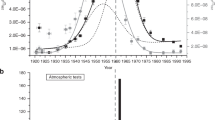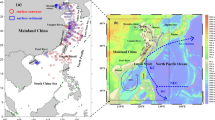Abstract
COSMIC RAYS create the long-lived radioactive nuclide 10Be (half life: 1.5 M yr) continuously in the upper atmosphere as a result of nuclear disintegrations. It enters the oceans through various paths and finally deposits in deep-sea sediment in a time which is short compared to its half life. This isotope has been used to establish the chronology of geophysical events up to the Pliocene1–7 or to suggest cosmic-ray intensity variations in the past8,9. This report shows that the 10Be stratigraphy in marine sediments can be used as a time marker for geophysical events in the past, but not for delineating any time variations in cosmic-ray intensity unless one can learn how to delineate geophysical effects. Also the cosmic-ray consistency would be estimated from the limits of 10Be variation implied by this data set.
This is a preview of subscription content, access via your institution
Access options
Subscribe to this journal
Receive 51 print issues and online access
$199.00 per year
only $3.90 per issue
Buy this article
- Purchase on Springer Link
- Instant access to full article PDF
Prices may be subject to local taxes which are calculated during checkout
Similar content being viewed by others
References
Peters, B. Proc. Int. Acad. Sci Sect. A 41, 67–71 (1955).
Arnold, J. R. Science 124, 584–585 (1956).
Peters, B. Z. Phys. 148, 93–111 (1957).
Goel, P. S. et al. Deep-Sea Res. 4, 202–210 (1957).
Merrill, J. R. et al. Geochim. cosmochim. Acta 18, 108–129 (1960).
Amin, B. S. et al. Deep-Sea Res. 13, 805–824 (1966); Geochim. cosmochim. Acta 39 1187–1192 (1975).
Inoue, T. & TandkS . Earth planet. Sci. Lett. 29, 155–160 (1976).
Higdon, J. C. & Lingenfelter, R. E. Nature 246, 403–405 (1973).
Kocharov, G. E. et al. Proc. 14th Cosmic-Ray Conf. Munchen, 3, 1009–1014 (1975).
Inoue, T. & Tanaka, S. INS-TCH-11, 1–10, Inst. for Nucl. Study, Univ. of Tokyo (1978).
Fujita, Y. et al. Nucl. Instrum. Meth. 128, 523–524 (1975); Proc. Int. Conf. on Low-Raioactivity Measurements and Applications, 1975 45–49 (The High Tatras, Czechoslovakia, 1977).
Tanaka, S. et al. Earth planet. Sci. Lett. 37, 55–60 (1977).
Kobayashi, K. et al. Deep-Sea Res. 18, 1045–1062 (1971).
Finkel, R. et al. Earth planet. Sci. Lett. 35, 199–204 (1977).
Somayajulu, B. L. K. Geochim. cosmochim. Act 41, 909–913 (1977).
Tanaka, S. et al. Geochem. J. 11, 171–176 (1977).
Author information
Authors and Affiliations
Rights and permissions
About this article
Cite this article
INOUE, T., TANAKA, S. 10Be in marine sediments, Earth's environment and cosmic rays. Nature 277, 209–210 (1979). https://doi.org/10.1038/277209a0
Received:
Accepted:
Issue Date:
DOI: https://doi.org/10.1038/277209a0
This article is cited by
-
Measurements of the long-lived radionuclides in environmental samples by accelerator mass spectrometry
Journal of Radioanalytical and Nuclear Chemistry Articles (1990)
-
Constancy of oceanic deposition of 10Be as recorded in manganese crusts
Nature (1982)
-
Cosmic ray effects in the solar system objects
Journal of Earth System Science (1980)
-
Radioisotope clocks in archaeology
Nature (1979)
Comments
By submitting a comment you agree to abide by our Terms and Community Guidelines. If you find something abusive or that does not comply with our terms or guidelines please flag it as inappropriate.



